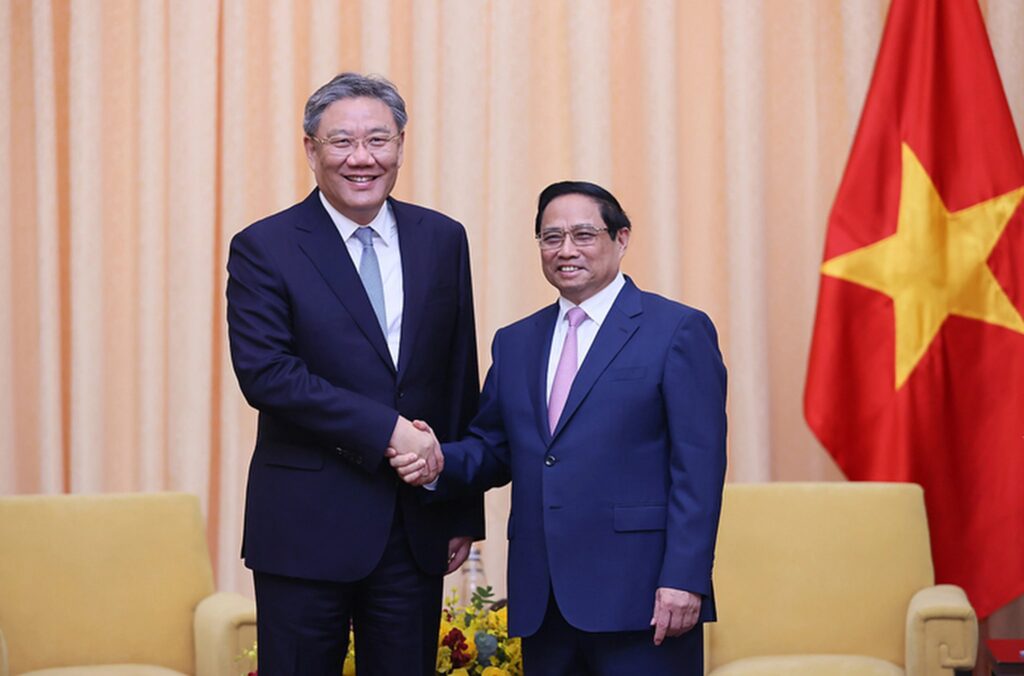Manufacturing heavyweights China and Vietnam have stepped up talks toward improving economic ties that could give Chinese railway contractors and hi-tech firms, among others, a stronger hold in the Southeast Asian country.
Chinese Minister of Commerce Wang Wentao told Vietnamese Prime Minister Pham Minh Chinh on Saturday in Ho Chi Minh City that the neighbours should cooperate on “interconnection”.
Pham, meanwhile, advocated the promotion of railway links, according to a statement from the Ministry of Commerce.
He also said Vietnam supported China’s bid to join the Comprehensive and Progressive Agreement for Trans-Pacific Partnership (CPTPP) trade pact, and that the two sides could discuss trade settlements in their own domestic currencies.
Wang Wentao’s trip came amid Beijing’s efforts to retain a resilient footing in the global supply chain realignment and improve ties with its major trading partners in Southeast Asia.
They want to have some railroads in and out of Vietnam, some short segments first
Nguyen Thanh Trung
China applied to join the 11-member CPTPP in September 2021, and any application to join the trade bloc must be approved by all members.
“The prime minister is very keen on improving Vietnamese infrastructure,” said Nguyen Thanh Trung, director of the Saigon Centre for International Studies at the University of Social Sciences and Humanities in Ho Chi Minh City.
“They want to have some railroads in and out of Vietnam, some short segments first.”
The 1,297km (806-mile) land border between China and Vietnam is a key conduit for Chinese trade with Southeast Asia.
Vietnam has found a formula of keeping maritime disputes separate from interactions between the two economies
Zha Daojiong
Trucks from Vietnam take farm produce to China, while China ships raw materials to Vietnam. Vietnam is China’s major trading partner in the Association of Southeast Asian Nations.
Vietnam and China have disputes over parts of the South China Sea, sometimes leading to maritime stand-offs, but relations have improved in recent years.
“Vietnam has found a formula of keeping maritime disputes separate from interactions between the two economies,” said Peking University international studies Professor Zha Daojiong, citing past cooperation on using marine resources in the shared Gulf of Tonkin, also known as the Beibu Gulf.
And Vietnam has become one of the popular investment destinations, as some foreign multinational companies relocate their supply chains from China, while Chinese companies have also moved production.
Wang said China will “carry out cooperation in strategic and emerging areas” including the digital economy and “green development”, according to the Chinese statement.
Wang also suggested allowing more “high-quality” Vietnamese products to be imported.
China has already accepted a surge of Vietnamese durians over the past year.
“Vietnam wants better trade relations with China and they want to promote more trade with China,” said Jack Nguyen, a partner at business advisory firm Mazars in Ho Chi Minh City.
China registered US$2.92 billion in direct investment in Vietnam over the first nine months of the year, 94.9 per cent higher than in the first three quarters of 2022, according to Vietnam’s Ministry of Planning and Investment.
Wang Qin, a professor at the Centre for Southeast Asian Studies at Xiamen University, said apart from the traditional labour-intensive production, Chinese tech and new energy firms have also started to invest in Vietnam.
This would, Wang Qin added, facilitate Beijing’s push for industrial transformation and the forging of regional industrial and supply chains.
“Amid the heightened strategic power play between the US and China, as well as Washington’s push for the Indo-Pacific Economic Framework, Vietnam has become a hotspot for China and the US in their rivalry in political, economic fronts,” said Wang Qin.
“Cooperation in new economic frontiers, such as digital economy, green transition and renewable energy, will determine the pattern and trajectory of economic ties between Beijing and Hanoi.”
The Biden administration introduced the Indo-Pacific Economic Framework for Prosperity in May 2022, and it is seen as the economic component of the US strategy to counter China in the Indo-Pacific.
China has already improved Vietnam’s supply chain by investing in casings for mobile phones or in facilities for testing electronic parts, said Frederick Burke, a Ho Chi Minh City-based senior adviser with law firm Baker McKenzie.
Source: SCMP


